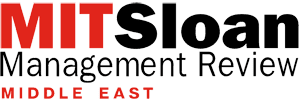Engineer Your Own Luck
Companies that modularize and externalize their best capabilities are in a strong position to seize unexpected opportunities.
News
- Ultra-High-Capacity Storage Is Becoming the Backbone of AI Ambitions in the GCC
- Private Sector to Outpace Governments in $20 Billion Earth Intelligence Market
- Saudi Arabia to Add 112MW to Data Centre Capacity in New Deal
- UAE Dominates Global Data Centre Rankings as Region Becomes Digital Infrastructure Hotspot
- AI Adoption Climbs 233% Globally with the Middle East Showing Similar Momentum, Report finds
- du Launches UAE’s First Sovereign Hypercloud for Government and AI Innovation

Neil Webb/theispot.com
Prediction is hard. The longer the time range — six months, three years, a decade — the less reliable any forecasting becomes. And yet, some companies prosper through extreme uncertainties.
Consider cosmetics giant L’Oréal. When COVID-19 unexpectedly struck the world, consumers rapidly shifted to online platforms. Many companies were unprepared, but L’Oréal quickly adjusted, ramping up digital efforts to offer beauty products and services online. Use of its virtual try-on technology increased by a factor of five, and conversion rates from virtual try-ons tripled. This pivot not only supported consumers but also aided retailers such as Amazon and Sephora, which adopted the technology for their sales of L’Oreal products. In addition, the digital team added functionality that allowed beauty influencers to host livestreaming events on L’Oreal’s own website.
L’Oréal’s swift response can be traced back to its 2018 purchase of ModiFace, which develops advanced augmented reality and virtual reality technology for the beauty sector. During the pandemic, it worked with 27 key strategic partners representing 30 countries to make ModiFace available on their websites for applicable L’Oréal brands, facilitating integration via a software development kit. Thanks to its modularized capabilities, the company was able to move quickly to capitalize on unexpected trends in the midst of a highly uncertain environment.
Our ongoing research shows that increased unpredictability and rapidly changing conditions demand that executives strategize at a higher level. Rather than focus solely on products and markets, leaders must develop the ability to discover and act on a company’s options — what is known as optionality — and to scale new initiatives quickly. That will position them to rapidly adjust to unforeseen market shifts, as L’Oreal did.
We see this formula for success in the face of uncertainty playing out across industries — Mastercard in finance, Haier in home appliances, Nvidia and TSMC in chipset design and manufacturing, and Xiaomi in consumer electronics. All have pursued a particular path to growth. They have modularized internal capabilities into plug-and-play, mix-and-match services that partners and clients can build on to grow new market segments. Even Nvidia’s recent success in AI can be traced back to its 2006 launch of a computing platform and related application programming interfaces (APIs) that made it feasible to use Nvidia’s powerful graphics processing units for general-purpose computing. That move opened new markets for the company’s chip designs in a variety of high-performance computing applications.
Put another way, the top-performing companies, ranked by a composite score we call the future readiness indicator, grow by sharing their capabilities with partners that will develop new markets. (See “Defining Future-Ready.”) Consequently, these companies can easily participate in multiple ecosystems, are resilient during difficult times, and are well positioned to capture unexpected upswings and opportunities. By treating capabilities as modular digital services, they can maximize their options for growth and scale quickly. That is how they engineer their own luck.
Defining Future-Ready
At IMD, we’ve compiled a future-readiness indicator to measure a company’s preparedness, focusing on the top players across six industries: automotive, consumer packaged goods, fashion, finance, pharmaceutical, and technology. This comprehensive ranking, based on seven equally weighted factors and encompassing 36 variables, evaluates the financial fundamentals crucial for future investment, including a healthy cash flow, cash on hand, and debt. Additionally, it assesses growth prospects through investors’ expectations and the intensity of investment in startups or new ventures.
Our analysis, which began in 2021, extends to the diversity within executive teams, highlighting the importance of gender, nationality, and industry diversity in promoting broadened perspectives beyond day-to-day operations. Productivity is gauged through metrics like operating revenue per employee, and the trajectory of new product rollouts is monitored to assess openness to new ideas and early innovation results. The balanced composite score derives from hard data sources, including financial reports, investors’ calls, LinkedIn profiles of the management team, CrunchBase, Factiva, and other publicly available reports, ensuring a robust assessment of each company’s future readiness.
Steps to Architect Optionality
If attaining optionality and speed is important, why don’t more companies do it? Because it requires grappling with four distinct challenges: (1) identifying core capabilities, (2) codifying relevant process knowledge, (3) breaking down complex, monolithic systems into loosely coupled modules, and (4) exposing interfaces to these modules so that others can harness them to develop new products and services. Overcoming these interrelated challenges requires leaders to be willing to make a long-term commitment and investment.
That commitment, in turn, requires courage, because the early stage of these initiatives are time consuming, can be resource intensive, and may not yield obvious payback aside from some internal productivity gains. But as the medieval theologian Thomas à Kempis observed, “The loftier the building, the deeper the foundation must be laid.” In this article, we’ll explain how to modularize your company’s core capabilities and show how leading companies have succeeded in doing this work, creating both optionality and agility for themselves.
Identify Core Strategic Capabilities
It starts with being clear about your most important strategic capabilities. For a financial services company, this may include the capability to enable secure and smooth payment transactions for clients, which directly ties to its core mission. For consumer packaged goods manufacturers, like L’Oréal, it may include the capability to effectively engage consumers or manage suppliers. In our research, we look at three dimensions of identifying such strategic capability: relevance, frequency, and uniqueness.
Relevance is defined by how important a capability is for continuing to create value for customers. Frequency refers to how often the capability is deployed; after all, if it’s deployed only once per year, there’s little use in providing it to partners. Uniqueness means that the capability should reflect what the company does best — how it gives the organization a unique advantage in the marketplace compared with competitors. With the capabilities to externalize identified, the next step is codification.
Codify Process Knowledge
It may sound straightforward, but taking steps to break down and codify the process knowledge underpinning strategic capabilities is the crucial prerequisite for pulling apart a complex, often monolithic process into simpler components and facilitating modularization.
To begin, don’t start with your most secret and critical process. Your goal is to make a handful of internal processes available to customers and partners to innovate faster. Focus on processes that are less sensitive. Maybe it’s the supplier onboarding process, or maybe it’s the process by which you seek out customers’ input during product development. Prioritize so you can start to codify.
A German chemical company that one of us has worked with is known for its expertise in molecular design and delivery of specialty chemicals for coatings. Perfecting the formulas for the desired outcome is crucial, whether that’s flame resistance, a smooth texture, scratch resistance, or water repellency. The company’s clients include car manufacturers, furniture makers, smartphone companies, and paint producers, all of which have diverse needs and unique requirements that change rapidly based on consumer demands.
Given stringent safety regulations in its sector, the company was already aware that it needed to begin to codify relevant process knowledge that tended to reside only in the brains of individual experts. The planned launch of a digital tool that would allow customers to virtually experiment with chemical recipes provided the impetus to get serious about documenting the company’s core capabilities. This required exposing critical process knowledge via a comprehensive, searchable, and user-friendly platform; and for that, the team needed to first codify that knowledge. They interviewed internal experts and pored through documents to detail each molecule, recipe, effect, and cost estimate. The resulting tool lets users see how various combinations of molecules can lead to new products and even estimates the cost of these new recipes. Capturing information on what users are investigating with the tool in turn provides insight to the R&D team about customers’ emerging needs.
Key to the success of this codification project was its narrow, well-defined scope. By focusing first on knowledge related to key clients’ most frequent needs, the team turned the company’s process knowledge from tacit and closely guarded into explicit and sharable. In contrast, we have seen large companies bogged down when they set the more ambitious agenda of codifying all process knowledge, as one CTO we know tried to do in support of a broad digital transformation.
Break Down Complex, Monolithic Systems Into Modular Capabilities
Once your company has identified the core capabilities that it can leverage with partners and customers and codified knowledge about related processes, the next step is to break those processes or systems into their component elements. Activating those specific, atomized capabilities involves calling on the workhorses of an agile digital architecture: APIs. These enable modularity by providing a standard way for software applications or components to communicate and exchange data or functionality. That modularity allows for fast changes, such as adding new functionality to a software suite without affecting other components.
Mastercard Labs, the global payment company’s R&D unit based in Dublin, Ireland, realized how critical APIs could be via some hard lessons. It built a cloud-based payment gateway that made it easier for small businesses to take credit cards, called Simplify Commerce, but found that scaling the product was impossible because the company’s core technology infrastructure was rigid and inflexible. Mastercard CEO Michael Miebach, who served as chief product officer from 2016 to 2020, observed that for a new product to thrive, the company would need to do some re-architecting of the core operation.
By a lucky coincidence, Mastercard Labs had also helped launch Mastercard Developers, which made APIs and other digital tools available to external developers so that they could integrate their innovations into the company’s network. “The way we constructed products was API-first. It was a lot more transparent. It was a lot more modular,” Miebach said. “So our ability to take something and plug it in somewhere else was much easier than before.” As the chief product officer, he spent years rewiring Mastercard internally so that APIs became the standard interfaces across departments and processes.
What Mastercard went through was nearly a complete overhaul. Operations such as fraud scores, security, token translations, and identity verification were all historically bundled into “The Transaction.” And while this core operation was tightly coupled, it also gave Mastercard its reputation for great stability, maintaining uptimes at 99.999% (which was not a metaphor but an actual metric, known throughout the company as “the five nines”). Yet it was the rigidity of these tightly coupled operations that prevented Mastercard from scaling new offerings like Simplify. In re-architecting the existing core, individual capabilities such as fraud detection, balance checking, and loyalty programs could be configured as mix-and-match components depending on new use cases. That now makes it easier for Mastercard managers to come up with modified offerings wherever and whenever they are needed. The result is true combinatory flexibility thanks to the modularized capabilities.
Mastercard’s challenges in modularizing systems are not unique. Most companies’ legacy systems, such as the classic version of SAP, are tightly coupled monoliths.
Breaking up a monolith can be long, slow work. It requires patience and commitment. Miebach recalls sitting in management committee meetings where, he said, “You feel like you’re having to explain and defend why the APIs you are so bullish on don’t always seem to be up to par.” Nonetheless, with regular, meticulous assessments and full transparency with leadership, both the quantity and quality of API-first offerings were inching upward. Mastercard eventually established what it calls the Single Front Door, a one-stop shop for all modular services. The benefits? Flexible scaling on demand.
With a modular setup, startups can mix and match Mastercard’s existing capabilities to meet the global regulatory environment. This self-serving approach is critical for Mastercard to cater to the long tail of requirements from the fintech world. It’s how Revolut, a fintech player based in the U.K., leveraged Mastercard’s modular capabilities to create disposable virtual cards, which change their number with every online transaction for added fraud protection. And it is how Grab, the Uber equivalent in Singapore, launched its GrabPay Card, accepted anywhere Mastercard is, allowing Grab app users to make transactions both online and offline globally as they travel.
In November 2023, Mastercard received authorization to have its cards linked to China’s biggest payment apps after years of being limited to cross-border services. The “pay like a local” feature was quick to implement. There was no more technology development at grand scale. Mastercard was ready whenever the opportunity materialized.
Open Your System to the External Ecosystem
As Mastercard’s example illustrates, a modular approach can speed internal innovation. After establishing a modular internal architecture through APIs, the next step to increase optionality is to extend the open architecture beyond your company’s boundary. This will enable your business to participate in multiple ecosystems at speed and scale.
China-based Xiaomi, a $50 billion consumer electronics company operating globally, has pursued a growth strategy built on partnerships. Its offerings span numerous categories, including smart phones, home appliances, and personal care items, with close to half of its revenues (44.9% in 2023) generated outside of China.
Xiaomi’s advantage in getting into new markets lies in its digital exchange platform. This is built around MiUI, the user interface, or “skin,” for its Android-based mobile phones, which are the center of the Xiaomi product ecosystem. Leveraging MiUI as a kind of universal remote control, the company began launching products that could be linked to and controlled by its phones, such as TVs, air conditioners, air purifiers, and smart lamps. But instead of scaling up R&D and operations to build new products, Xiaomi scouted for hundreds of partners that could build out this new range of offerings. What Xiaomi essentially did was open its internal architecture to third parties.
A small team led by one of the cofounders, Liu De, makes final decisions to sign new partners. But these decisions are informed by feedback from the active and engaged MiUI user community, which has been suggesting new features since the platform was merely a phone interface. By analyzing this large-scale feedback, Xiaomi can understand what products or features customers want. To facilitate product integration into the Xiaomi ecosystem, the company provides partners with a software development kit and an open API suite.
This strategy was informed by Xiaomi’s deep belief in competing as a “bamboo forest” rather than as “the largest single tree.” MiUI became the intricately connected underground root system that enabled new bamboo shoots — the new product categories — to sprout. Today, Xiaomi boasts an impressive connected ecosystem, orchestrating over 330 companies with 2,700 SKUs.
Similarly, L’Oréal’s ModiFace has expanded into a full suite of API services for third-party deployment. It started with internal capabilities, morphed into a plugin for Amazon.com and Sephora, and was then made broadly available.
Thriving in today’s ambiguity demands companies move away from a rigid, manual-based structure to a flexible, modular setup. However, you must get your own house in order before you can fully leverage the benefits of opening your company’s ecosystem. As a first step, identify a small number of customers or partners. Or, work with a small but avid fanbase so that the early crowd of adopters will buy into your vision of growing together.
Pioneers have showed us the way. These companies swapped out their organizational silos for standardized knowledge bases. They tore down their once-monolithic structures to create modular setups. They flung their doors wide open, sharing their tools with others. Using digital interfaces like open APIs, they slashed the cost of collaboration. These trailblazers offer a key path to staying forward: Treat capabilities as services. That is how to maximize optionality while scaling at extreme speed.
Being prepared for the unexpected will help you engineer your own luck.





